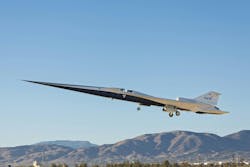Lockheed Martin and NASA complete first flight of X-59 quiet supersonic demonstrator
Summary Points:
- The aircraft flew from Palmdale, Calif., to NASA’s Armstrong Flight Research Center in Edwards, Calif., to verify basic handling and data systems.
- X-59 aims to demonstrate supersonic flight with a significantly reduced sonic boom.
- Flight data will inform new standards for potential commercial supersonic operations over land.
PALMDALE, Calif. - Lockheed Martin Skunk Works, working with the National Aeronautics and Space Administration (NASA), has conducted the first flight of the X-59 quiet supersonic demonstrator aircraft, marking a key milestone in efforts to reintroduce commercial supersonic travel over land.
The experimental X-59 aircraft took off from Skunk Works’ facility at U.S. Air Force Plant 42 in Palmdale, Calif., and landed safely near NASA’s Armstrong Flight Research Center in Edwards, Calif. The flight confirmed initial handling characteristics and air data system performance.
OJ Sanchez, vice president and general manager of Lockheed Martin Skunk Works, said the first flight validated years of development. "This aircraft represents the skill and dedication of our joint team," Sanchez said. "It’s an important step toward realizing practical, quiet supersonic flight."
Related: Lockheed Martin and Saildrone collaborate on uncrewed surface vessels with maritime weapons
The single-seat X-59 is designed to demonstrate the ability to cruise faster than sound while producing a minimal sonic boom - reduced to what engineers describe as a "gentle thump." Data gathered from the aircraft will support NASA’s effort to establish acceptable sound thresholds for overland supersonic flight, a capability currently restricted by international noise regulations.
Flight test and data systems
Lockheed Martin and NASA will continue flight testing at Edwards to expand the X-59’s flight envelope and collect acoustic data during upcoming supersonic runs. Those tests will include community response studies to measure how people perceive the aircraft’s reduced sonic signature.
A central component of the flight program is the Flight Test Instrumentation System (FTIS), which gathers and transmits thousands of parameters in real time, including audio, video, sensor, and avionics data. "We record 60 data streams with over 20,000 parameters on board,” said Shedrick Bessent, NASA X-59 instrumentation engineer in September ahead of the maiden flight. "Before we even took off, the system had already logged more than 200 days of operation."
According to NASA, the FTIS has already generated more than 8,000 data files across 237 days of testing. That extensive baseline allows engineers to verify system performance and confirm aircraft readiness before the flight.
Related: White House makes order to lift ban on overland supersonic flight
"There’s so much new technology on this platform, and having reliable data helps validate what’s working," Bessent said. "It builds confidence across the entire team."
Advanced flight control and safety systems
The X-59 incorporates a digital fly-by-wire control system to stabilize flight and prevent unsafe maneuvers. Originally pioneered by NASA in the 1970s, fly-by-wire replaces mechanical linkages with computerized flight control logic.
For the X-59, pilot commands are converted to digital signals and transmitted through fiber-optic lines to the control surfaces. Redundant flight computers provide backup, ensuring continuous operation even if one fails. Independent hydraulic and electrical backups further increase safety margins.
Power resilience is reinforced through onboard and thermal batteries that drive the hydraulic pumps, along with an emergency hydrazine-based engine restart system designed to recover power during an in-flight shutdown.
Related: Hermeus tests Quarterhorse Mk 1 in its hypersonic aircraft development
At cruise altitudes approaching 55,000 feet, the X-59’s environmental and life-support systems deliver oxygen directly through the pilot’s mask to maintain safe cabin pressure -more than twice the altitude of a standard commercial airliner.
NASA and Lockheed Martin expect the X-59 test program to continue through 2026, with acoustic data informing future commercial and regulatory frameworks for overland supersonic flight.
About the Author

Jamie Whitney
Jamie Whitney joined the staff of Military & Aerospace Electronics and Intelligent Aerospace. He brings seven years of print newspaper experience to the aerospace and defense electronics industry.
Whitney oversees editorial content for the Intelligent Aerospace Website, as well as produce news and features for Military & Aerospace Electronics, attend industry events, produce Webcasts, oversee print production of Military & Aerospace Electronics, and expand the Intelligent Aerospace and Military & Aerospace Electronics franchises with new and innovative content.
